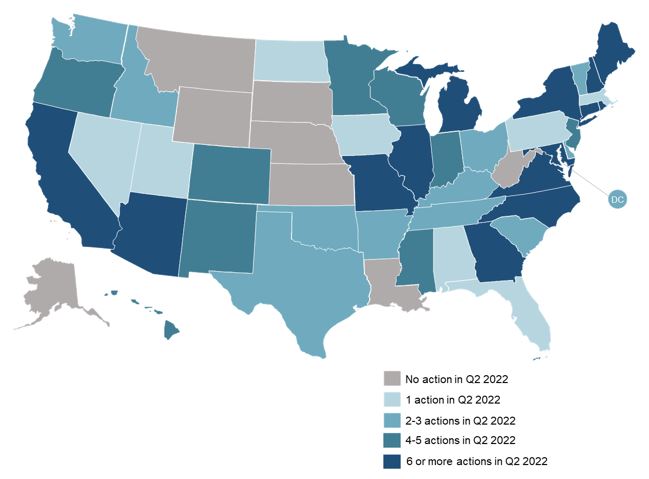The 50 States of Grid Modernization Q2 2022: States Address Interconnection, Financing, and Data Access in Q2 2022
Raleigh, NC – (July 29, 2022) The N.C. Clean Energy Technology Center (NCCETC) released its Q2 2022 edition of The 50 States of Grid Modernization. The quarterly series provides insights on state regulatory and legislative discussions and actions on grid modernization, utility business model and rate reforms, energy storage, microgrids, and demand response.
The report finds that 48 states, as well as the District of Columbia, took actions related to grid modernization during Q2 2022 (see figure below), with the greatest number of actions relating to energy storage deployment (81), utility business model reforms (50), smart grid deployment (45), advanced metering infrastructure deployment (30), distribution system planning (28), and time-varying rates (24).
A total of 549 grid modernization actions were taken during Q2 2022. California, New York, Massachusetts, Minnesota, Illinois, Michigan, and Hawaii took the greatest number of actions during the quarter, followed by Connecticut, New Jersey, Arizona, and Colorado.
Q2 2022 Legislative and Regulatory Action on Grid Modernization

The report discusses three trends in grid modernization actions taken in Q2 2022: (1) states considering cost-sharing for grid upgrades needed for distributed energy resource interconnection; (2) states expanding financing programs for energy storage and grid resilience; and (3) states and utilities enhancing access to energy usage data.
“This quarter, we noted some developments in the implementation of FERC Order 2222. Regional Transmission Organizations and Independent System Operators have compliance plans under review, and MISO’s compliance task force released a new charter,” said Vincent Potter, Policy Analyst at NCCETC. “Also, state utilities commissions in Michigan, Missouri, and Vermont have pending actions regarding utility regulations for market participation of distributed generation resources.”
The report notes the top five policy developments of Q2 2022 were:
- Arizona Public Service filing a distributed demand-side resource aggregation tariff;
- The Illinois Commerce Commission completing its energy storage study;
- Colorado lawmakers enacting energy storage and resilience legislation;
- The Connecticut Public Utilities Regulatory Authority releasing a straw proposal on reliability and resilience frameworks; and
- Hawaii regulators adopting additional performance incentive mechanisms.
“Many states are integrating energy storage resources into their resource planning requirements; energy storage is not only being used as a resiliency service or backup plan, but also more broadly as another resource for utilities and customers to rely on,” said Rebekah de la Mora, Policy Analyst at NCCETC.
View the 50 States of Grid Modernization Q2 2022 Quarterly Report Executive Summary
View and Purchase the 50 States of Grid Modernization 2022 Q2 Update FULL Report
View other 50 States Reports – Solar, Grid Modernization and Electric Vehicles
ABOUT THE N.C. CLEAN ENERGY TECHNOLOGY CENTER
The N.C. Clean Energy Technology Center, as part of the College of Engineering at North Carolina State University, advances a sustainable energy economy by educating, demonstrating and providing support for clean energy technologies, practices and policies. It serves as a resource for innovative, sustainable energy technologies through technology demonstration, technical assistance, outreach and training. For more information about the Center, visit: http://www.nccleantech.